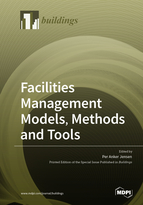Facilities Management Models, Methods and Tools
A special issue of Buildings (ISSN 2075-5309). This special issue belongs to the section "Construction Management, and Computers & Digitization".
Deadline for manuscript submissions: closed (31 January 2021) | Viewed by 20192
Special Issue Editor
Interests: facilities management; construction management; briefing, knowledge transfer; sustainable buildings; building renovations
Special Issues, Collections and Topics in MDPI journals
Special Issue Information
Dear Colleagues,
The starting point for this Special Issue is the book “Facilities Management Models, Methods and Tools: Research Results for Practice” (Jensen, 2019) edited by the Guest Editor [1]. The book presents research on Facilities Management (FM) since 2008 at a research centre in Denmark with particular focus on models, methods and tools applicable for practice. The research covered the following six themes:
- Facilities that support users and activities;
- Sustainability from goal to action;
- Innovation and partnerships;
- Transfer of knowledge from FM to building projects;
- FM and added value;
- FM organisation and development.
The book also presents five main challenges and processes for facilities managers and shows how the different models, methods and tools can be used to manage one or more of these processes. The five processes are:
- Strategy development;
- Organisational design;
- Space planning;
- Building project;
- Optimisation.
This Special Issue aims to expand this research with further models, methods and tools of relevance to FM. This can include research with a practical application, but it can also include more genuine theoretical models, which can contribute to a deeper understanding of the field of FM. The research can be related to the mentioned themes and challenges, but it can also concern other themes and challenges.
Papers for the Special Issue should have a clear theoretical basis. Both conceptual papers and empirical studies are welcome. Related to the scope of the journal, a life cycle perspective on management of buildings and facilities will be favoured.
Reference:
[1] Per Anker Jensen (ed.) Facilities Management Models, Methods and Tools – Research results for practice. Routledge, Oxfordshire, UK. June 2019.
Prof. Dr. Per Anker Jensen
Guest Editor
Manuscript Submission Information
Manuscripts should be submitted online at www.mdpi.com by registering and logging in to this website. Once you are registered, click here to go to the submission form. Manuscripts can be submitted until the deadline. All submissions that pass pre-check are peer-reviewed. Accepted papers will be published continuously in the journal (as soon as accepted) and will be listed together on the special issue website. Research articles, review articles as well as short communications are invited. For planned papers, a title and short abstract (about 100 words) can be sent to the Editorial Office for announcement on this website.
Submitted manuscripts should not have been published previously, nor be under consideration for publication elsewhere (except conference proceedings papers). All manuscripts are thoroughly refereed through a single-blind peer-review process. A guide for authors and other relevant information for submission of manuscripts is available on the Instructions for Authors page. Buildings is an international peer-reviewed open access monthly journal published by MDPI.
Please visit the Instructions for Authors page before submitting a manuscript. The Article Processing Charge (APC) for publication in this open access journal is 2600 CHF (Swiss Francs). Submitted papers should be well formatted and use good English. Authors may use MDPI's English editing service prior to publication or during author revisions.
Keywords
- facilties management
- working environment
- sustainability
- innovation
- partnerships
- knowledge transfer
- added value






